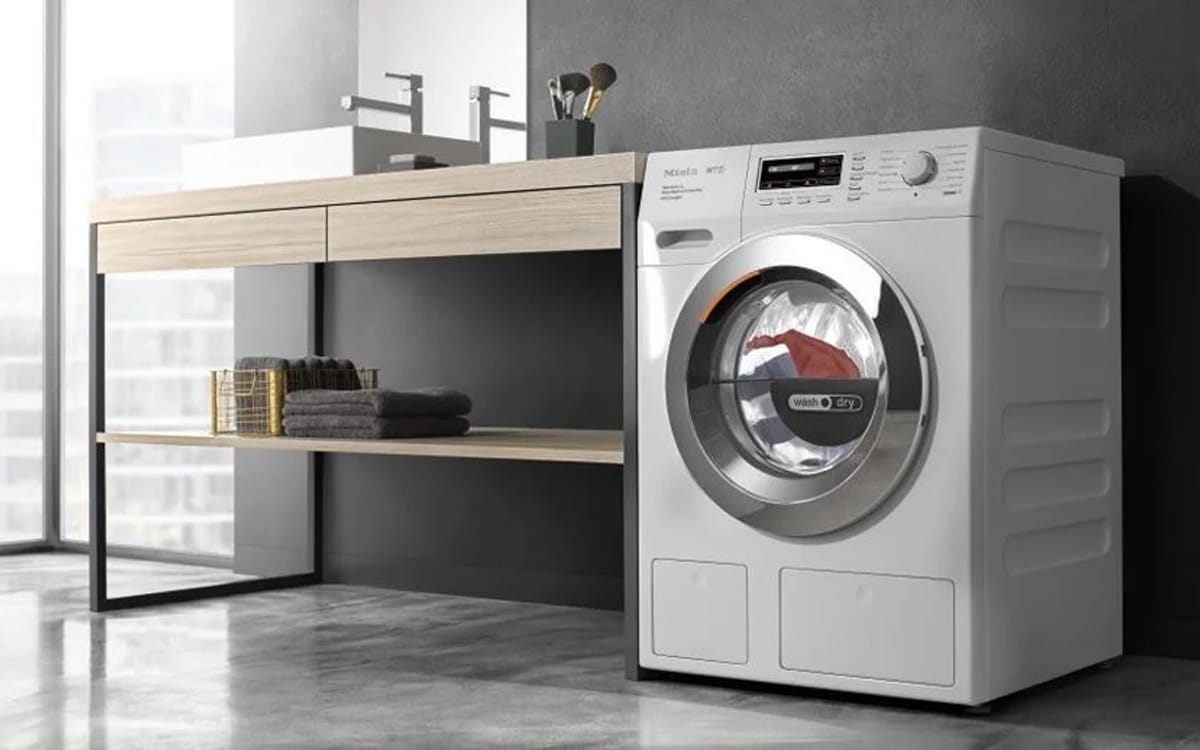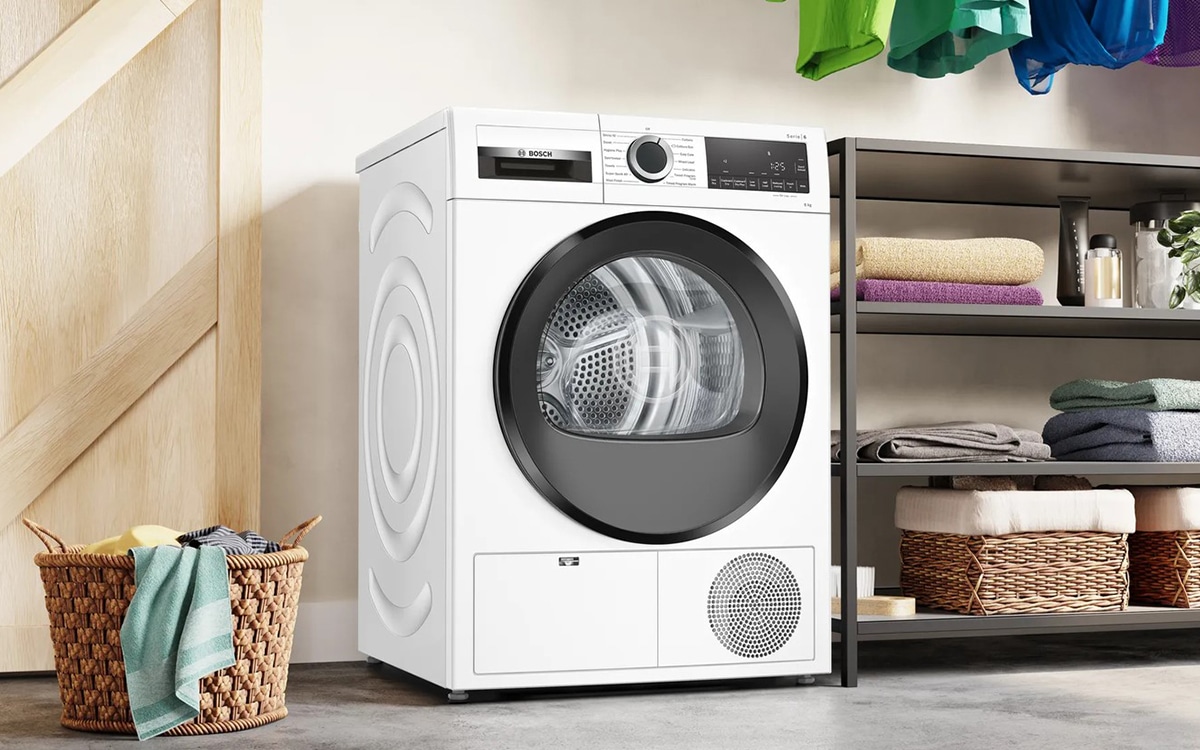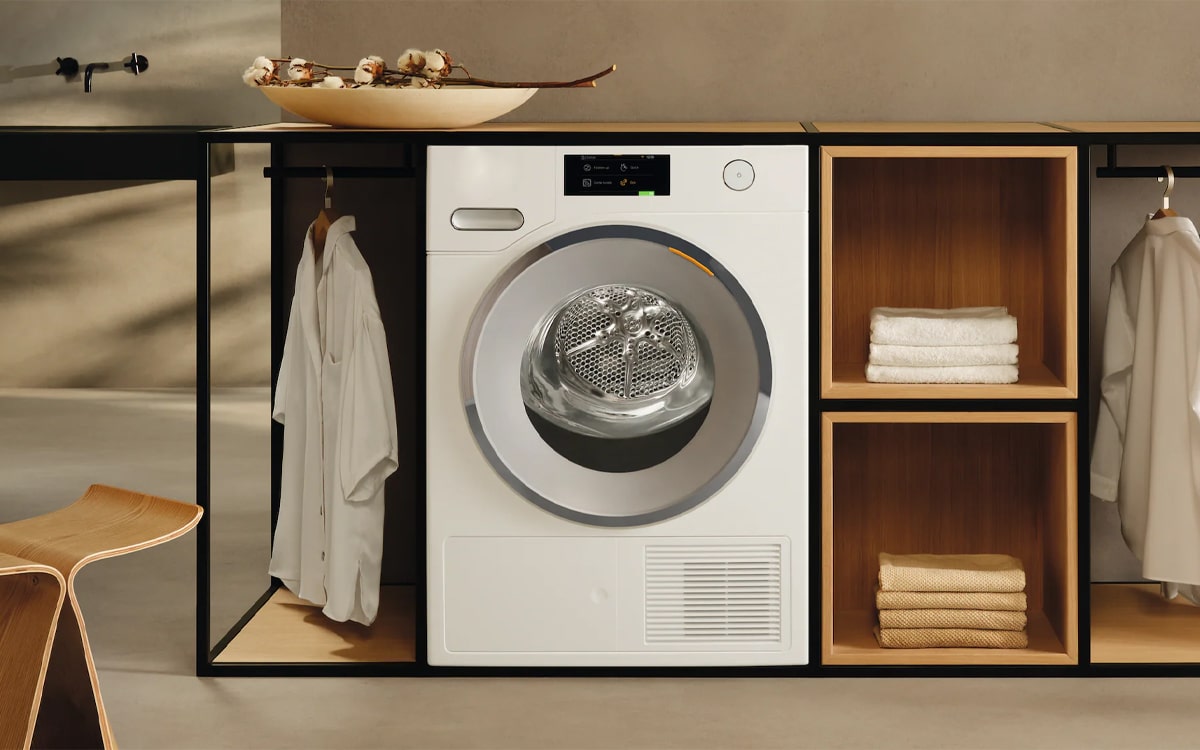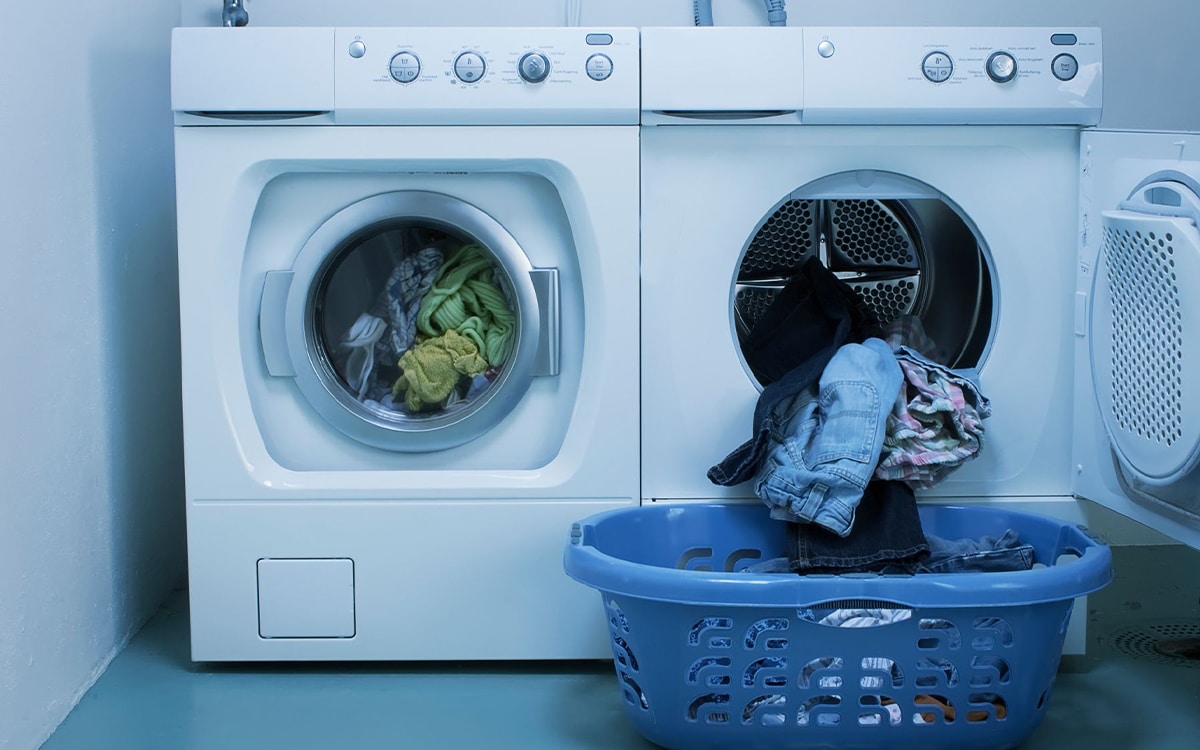Tumble dryers can help to save you the hassle of unloading and hanging all of your soggy laundry after every wash cycle. Which can really free up your time to crack on with something more important.
But there’s much more to these appliances than meets the eye. Are you planning on grabbing your first tumble dryer? Maybe you want to get to grips with one you already have? Either way, there’s plenty to learn about these unique and handy appliances.
Our Reliant tech experts have over 60 years of experience with appliances across the spectrum. We asked them to lend us their wisdom to put together this definitive guide to tumble dryers. So that you can gather everything there is to know, whether you’re new to them or not! Let’s get started!
How Does A Tumble Dryer Work?
Tumble dryers essentially work by drawing out the moisture from your freshly-washed clothes, and then sending that moisture elsewhere. There are two distinct types of tumble dryer that do this differently. One is the “Vented” type. This type takes the moisture from clothes and directly vents it from the unit, sending all of the evaporated water, through the air, outside of the home. The other type is a “Condenser” dryer. Instead of venting moisture, this type collects the water in a reservoir, before it is drained away.
The key component of either of these types is the motor. This is responsible for spinning the central drum. The central drum is filled up with your soggy clothes and spins on its axis. This motion helps to wick the moisture out of the laundry. The motor is also responsible for spinning a small fan that circulates hot air throughout the unit. This hot air helps to evaporate the moisture in your clothes. The evaporated water is then either vented or collected.
Tumble dryers, true to their name, use a combination of motion and hot air to draw out moisture from your clothes. This moisture is then either vented or collected for later drainage.
The water collected by a condenser dryer is either drained away by hand, by pulling out the reservoir, or through existing plumbing.
Whether you have a vented or condenser tumble dryer, you can count on the appliance to efficiently dry your clothes in no time!
What Is A Heat Pump Tumble Dryer?
One distinct type of tumble dryer that has been making waves in the world of appliances is the “Heat pump” tumble dryer. This distinct variety is specially designed to be more energy efficient, thanks to how they recycle air.
Tumble dryers make use of hot air to help evaporate the moisture on clothes. The trouble is that much of the heat from this air stays latched onto the evaporated moisture. This means that when the moisture is vented or collected, the heat from the air is lost. As such, the average tumble dryer has to keep generating heat continuously in order to ensure a stable temperature. Heat pump tumble dryers do things a little differently.
The moisture that is collected by a heat pump tumble dryer is sent through an evaporator. This nifty extra is designed to separate the hot air from the moisture. This allows the hot air to then cycle back into the drum. In turn, heat pump tumble dryers use much less electricity, because they are not charged with constantly generating hot air.
If you’re seeking to cut down on your energy bills, it might be worth looking out for one of these!
Should You Get A Tumble Dryer Or A Washer Dryer?
Tumble dryers are most often purchased in combination with a separate washing machine. The trouble is that having both appliances at the same time can be totally unviable for some households. Both of the appliances have very sizable footprints, so they take up a lot of space. As such, many people opt to grab washer dryers, which are designed to condense the two into a single appliance.
You might wonder to yourself whether there’s any point in grabbing a separate tumble dryer. Especially if a washer dryer can supposedly do the job just as well.
Ultimately, it depends on how often you need to dry your clothes. If you’re often cycling through massive loads of laundry, perhaps for the whole family, then a tumble dryer is totally worth it. As handy as washer dryers are, they’re not great for drying massive loads of laundry. For one, a washer dryer should only be half full, in order for the cycle to be done effectively.
As well as this, while a washer dryer is performing a drying cycle, the washer is completely occupied. This means that you will have to wait longer to wash another load of laundry. With a separate washing machine and tumble dryer, you can run the two appliances simultaneously. This means that you can work through a massive laundry load in no time!
Finally, it’s also worth noting that a washer dryer takes much longer to dry your clothes. This is because it operates differently from an ordinary tumble dryer.
Tumble dryers are absolutely the best option for those who frequently need to dry laundry. Washer dryers are best for those that only sparingly use the drying function.
Do Tumble Dryers Consume A Lot Of Electricity?
Unfortunately, tumble dryers still have a reputation for consuming a massive amount of electricity. This goes some way to explaining why they are often viewed as a luxury appliance by many people.
On average, it can cost you anywhere from £1 to £1.50 to perform an average drying cycle. If you were to dry your clothes every time you did your laundry, you’d very quickly find your electricity bills climbing.
Tumble dryers do use up a lot of electricity in order to generate the perfect heat. However, heat pump tumble dryers recycle hot air in order to cut down on energy use by up to 60%!
However, tumble dryers are now much more efficient than they once were. Unique varieties like “Heat pump” tumble dryers are able to consume far less electricity. If manufacturers continue to innovate, it’s likely that the cost of running a tumble dryer could continue to decline.

What Should You Look Out For In A Tumble Dryer?
No doubt, all of this talk of tumble dryers has piqued your interest. If you’re keen to grab one of your own, to help handle your laundry woes, there are a few things you’ll need to consider. Don’t rush into purchasing a tumble dryer, because you don’t want to end up with a model that doesn’t suit you. Take a look at all of the following factors down below to make the right choice!
Type
We started this guide by taking a look at some of the major types of tumble dryer available. It’s a good idea to consider the type you’re looking for from the start. This helps to narrow down your options, to make the ongoing search far less daunting.
You’ll want to decide between a vented or condenser tumble dryer. Both operate mostly the same way, but ultimately dispose of moisture in different ways. Vented tumble dryers are very convenient because they can extract the moisture from your clothes, and then send that moisture outside of the home. Out of sight, and out of mind! However, if you’re going to opt for one of these models, you’ll need to make sure it’s properly plumbed in.
Do you want a vented or condenser tumble dryer? It’s important to choose between one of the two types to get your tumble dryer hunt off to a more simplified start!
If you can’t hook up your new tumble dryer to your plumbing system, then you’ll need to opt for a condenser tumble dryer. Condenser tumble dryers collect the moisture from your clothes, and then deposit it into a reservoir. All you need to do is remove the reservoir between cycles, and drain it out.
It’s also worth considering a heat-pump model. These can recycle hot air to reduce operating costs. Though they may cost a little more up-front, they’ll help you to really save on your energy bills.
Size
Most likely, your new tumble dryer will be working in tandem with a nearby washing machine. As such, it’s important to make sure you have more than enough space for it. Tumble dryers can be just as large as washing machines, and without enough space, they can be tough to find a spot for.
Make sure to choose a spot for your new tumble dryer, and to get some good measurements. This will help you to decide on a unit size. Preferably, your tumble dryer should not be too big or too small. It should reach a nice middle ground.
Make sure there’s plenty of space around your new tumble dryer. It should not be placed too close to other objects. Tumble dryers naturally vibrate while in operation. Allowing a wide enough berth around the machine ensures that it won’t end up bashing against anything! This will help to really save you some peace of mind!
Capacity
Naturally, when talking about unit size, we lead quite naturally into discussing unit capacity. The larger the tumble dryer is, the larger its capacity usually is too. You’ll need to consider just how much laundry you plan to dry. If you need to dry laundry for the whole family, then it’s best to get a model with plenty of capacity. This will cut down on the number of cycles you need to perform and also cut down on operating costs.
If you only need to dry clothes for one or two people, then you might be better suited to a smaller model. This will cost less to operate, and will not result in wasted electricity.
Energy Efficiency
At this point, it’s no secret that tumble dryers use a lot of energy. So, you’ll want to make sure your new one is as efficient as possible. Want a truly efficient tumble dryer? Then be sure to look out for each model’s energy rating!
The energy rating of any tumble dryer is determined by how efficient it is. Its efficiency is decided based on its overall capacity, and the amount of energy it uses for a single average cycle. Its efficiency is then rated using a sliding scale. If an appliance is rated toward the top of the scale, at “A”, it’s considered highly efficient. If it ranks towards the bottom, at “G”, it’s considered very inefficient.
The highest ratings most tumble dryers achieve tend to be around “C” and “D”. If you’re looking for your first tumble dryer, we strongly recommend targeting these particular ratings.
It’s worth looking for an energy-efficient tumble dryer. Not only is it great for the health of the planet. It could also help you to shake the “Luxury”-reputation usually attached to the appliances!
And we also have to mention, once again, the benefits of heat-pump tumble dryers. We’d be surprised if you weren’t tired of hearing us talk about them. They’re great for the energy-conscious because they use far less electricity, and thus cost less to operate.
Noise Level
It’s important to ensure your new tumble dryer has plenty of space to prevent any horrible operating sounds. If you’re especially conscious of the noise a tumble dryer might make, then it’s worth taking a look at the noise level of each model.
Most manufacturers will declare the decibel level of every appliance they sell. Generally, you want to look for around 50 dB or lower for quiet operation. 50dB is around the noise level of average conversation. Any louder than this, and your tumble dryer could quickly drive you mad!
Ease Of Use
Tumble dryers don’t simply chuck your clothes around and pump them with warm air every time. Many modern tumble dryers actually come with special pre-programmed drying cycles. However, in order to make the most of these different cycle types, you’ll need to ensure your tumble dryer is easy to use. Towards this end, look for models with simple user interfaces.
User interfaces can differ quite a lot depending on the model of tumble dryer you’re using. For instance, one model might have simple buttons, while another might have a twisting dial to cycle between options. You’ll want to pick the user interface that best suits you and your unique needs.
Your tumble dryer should allow you to easily control the temperature, the length of the cycle, and how dry you want your laundry to come out. This is crucial for ensuring your laundry is kept safe. You won’t end up with the horrible shock of pulling out your clothes just to find that they’ve shrunk during the cycle!
It’s always worth looking for a tumble dryer that’s easy to control. With smart controls, you can more easily make full use of the unit’s numerous capabilities! A tumble dryer should never be a hassle to use!
If you want total control over your tumble dryer, it’s also worth checking out some smart models. Smart tumble dryers can use your local wifi to connect directly to your smartphone. This enables you to operate the appliance entirely remotely. Forgotten to set a drying cycle off, but you’ve already left the house? Just use your phone! Smart tumble dryers are also beneficial because they can help with maintenance. If any errors occur during a cycle, or any components are damaged, the appliance can let you know directly!
Additional Features
The world of tumble dryers is populated with all kinds of different models. And each of these different models offers its own set of extra features to draw your attention. It’s worth taking the time to look through these different features because they really can vary in massive ways.
For instance, if you often have to iron your clothes right after drying them, you could save yourself the trouble by opting for a tumble dryer with crease prevention. In order to prevent creases, some models will perform a small and gentle spin after the cycle has finished. This helps to keep your fabrics moving, which in turn prevents them from folding and creasing!
As we explored earlier, some tumble dryers can also connect directly to the internet, and to your smart device. This is an additional feature that’s totally worth looking out for. Especially if you want a model that’s efficient and easy to use.
Price
Once you’ve whittled your list down to just a few options, the next thing to check out is the price. You don’t want to spend too much on your new tumble dryer, just like you don’t want to spend too little!
The price of your tumble dryer will be directly affected by its size, features, and other factors. Be sure you know what you want from the appliance so you can find a model that suits you, at a good price!
The price of any tumble dryer will be affected directly by some of the factors we discussed above. For instance, a larger tumble dryer with a jumbo capacity will cost you much more than a tumble dryer with a smaller capacity and footprint. Features such as smart connectivity and crease prevention will result in a much higher price tag.
Be sure to consider exactly what you want out of your tumble dryer, and how much you’re willing to spend. This will help you to settle on a model that offers a fair price and has all of the features you require.

How Much Should You Fill Your Tumble Dryer?
A good rule of thumb is to fill up your tumble dryer to just over full. We’d recommend no more than two-thirds full. This ensures you make full use of all of the hot air, but also gives the laundry room to move. The motion of the laundry, within the drum, plays a crucial role in helping to extract moisture from them. If they are too tightly packed together, you run the risk of pulling them out at the end of a cycle, still dripping with water!
You should fill your tumble dryer up to around two-thirds. This ensures you’re making full use of the unit, while still ensuring there’s space for the clothes to move around. Motion is crucial to the drying process!
It’s also best not to overfill or underfill the drum for the sake of the tumble dryer itself. When an insufficient amount of weight is placed in the unit, it can cause the drum to spin off of its axis. This can cause immense damage to the unit. It’s also simply a waste of electricity.
How Often Should You Check Your Tumble Dryer’s Lint Filter?
Really, you should aim to check on your tumble dryer’s lint filter between every use. Luckily, this is very easy. Just pull the filter out, and pick away the pieces of lint that have been trapped by the end of a cycle.
It’s important to clean out your tumble dryer’s lint filter as often as possible. It helps to ensure that it can work at its best moving forward. When the filter is filled up with lint, it makes it tougher for further lint to be captured.
How Often Should You Clean Your Tumble Dryer?
It’s best to clean your tumble dryer at least once a month. Again, this isn’t too difficult of a task. All you need is a damp cloth, a little bit of soap, and some elbow grease. Simply scrub the interior of the tumble dryer’s drum, to clean away any dirt or leftover lint. This helps to keep the drum working at its best and helps to prevent the development of bacteria and mould. This further ensures your clothes don’t come out of the appliance with a strange odour.
What Temperature Should Your Tumble Dryer Be?
This entirely depends on the kind of cycle you need to perform, and the kinds of fabrics you’re taking care of.
When drying a larger load of clothes, it’s best to go for a slightly higher temperature. We recommend around 60 degrees Celsius. This ensures a full and efficient drying cycle. This temperature is generally intended for heavy cotton and materials like denim. These materials are heavy-duty and very durable.
If you intend to dry delicates, such as silk and wool, then 50 degrees Celsius and lower is more appropriate. This keeps the fabrics safe and prevents them from shrinking. Make sure to check any wool items to be sure they’re safe to tumble dry, before setting a cycle off!
What Shouldn’t You Put In A Tumble Dryer?
There are a few things you should avoid putting in the tumble dryer.
For the most part, it’s best to avoid placing delicates in there. If you plan to tumble dry any delicates, you should make sure they’re marked as safe for tumble drying. If not, they should not be placed inside.
You should also avoid tumble-drying clothes with glued-on decorations, or hanging decorations like sequins. These can easily be damaged and removed from the fabric. The intense temperatures could cause the glue to melt, and the force of the tumbling cycle could rip sequins from the clothes!
There are a few items that shouldn’t be placed into a tumble dryer. Perhaps most importantly, you should avoid placing delicates into the appliance. At the wrong temperatures, delicate items can be damaged.
Spandex is also a material that doesn’t take well to the drying process. This is because the intense temperatures can have a direct and negative impact on the quality of the flexible material. This then results in spandex clothing becoming less flexible, and more likely to tear!
How Can You Save Money With A Tumble Dryer?
If you’re worried that a tumble dryer might cost you a little too much to operate, there are a few things you can do.
If you’ve yet to grab a tumble dryer, then a great step is to grab a heat pump model. As explored earlier, these are able to cut down on energy usage by up to 60%. This makes them cheaper to use with every single cycle.
It’s also best to make full use of the unit’s capacity. Don’t just drop in a few clothes for a quick cycle. Build up a decent-sized laundry load and drop that in. This ensures that none of the electricity goes to waste, and also cuts down on the number of cycles you need to perform.
The best way to save money while using a tumble dryer is to use it efficiently. Make full use of its drum capacity, and fill the unit to around two-thirds full.
Make sure to separate the items out before moving them from a washing machine into a dryer. This ensures there’s air moving between each of the garments, for a full and quicker dry.
Finally, make sure to keep your tumble dryer clear from lint. Be sure to clean out the lint filter and check for any lint that may have built up in the drum. Built-up lint can make it difficult for hot air to travel around the unit. This can lead to ineffective drying.
Is It Cheaper To Run A Tumble Dryer At Night?
Technically speaking, it is much cheaper to operate a tumble dryer at night. This is because, between the hours of 10 PM and 5 AM, there is less demand placed on the grid. In turn, it costs less to use electricity.
However, we would not recommend running your tumble dryer while you are asleep. This is because leaving your tumble dryer unattended could pose a fire risk. If you want to take advantage of off-peak times when using your tumble dryer, it’s recommended that you do it while you’re still awake!
What Happens If You Leave Clothes In The Tumble Dryer?
Another reason you should try to avoid running your tumble dryer while asleep is that your clothes will be left sitting there for hours after the cycle finishes. If left for too long after drying, your clothes are at a very high risk of creasing. This would mean you’d have to dig out the trusty iron to flatten them back out.
Don’t leave your clothes in the tumble dryer for more than an hour, before or after running a cycle. This is because soggy clothes run the risk of getting mouldy, while dry clothes run the risk of creasing.
It’s also best to not leave your clothes in the tumble dryer for too long before performing a drying cycle. This is because soggy clothes are at high risk of developing mould and bacteria when left lying around. It’s not only unsanitary but also creates a horrible odour that will stick to your clothes!
Frequently Asked Questions
How Does A Tumble Dryer Work?
Tumble dryers work by evaporating the moisture in your laundry. This moisture is then carried, through the air, out of the central drum. From here, the water is disposed of in different ways depending on the type of tumble dryer. A ventilated model will send the evaporated moisture outside of the home. A condenser tumble dryer will collect the moisture in an isolated reservoir. Ready to be poured away.
Do Tumble Dryers Need To Be Plumbed In?
Most standard tumble dryers require no plumbing at all. This is because they collect the water from your clothes and deposit it into a reservoir. It’s your job to then empty that reservoir at the end of the cycle. However, vented tumble dryers may need to be plumbed in, so that they can dispose of water for you.





